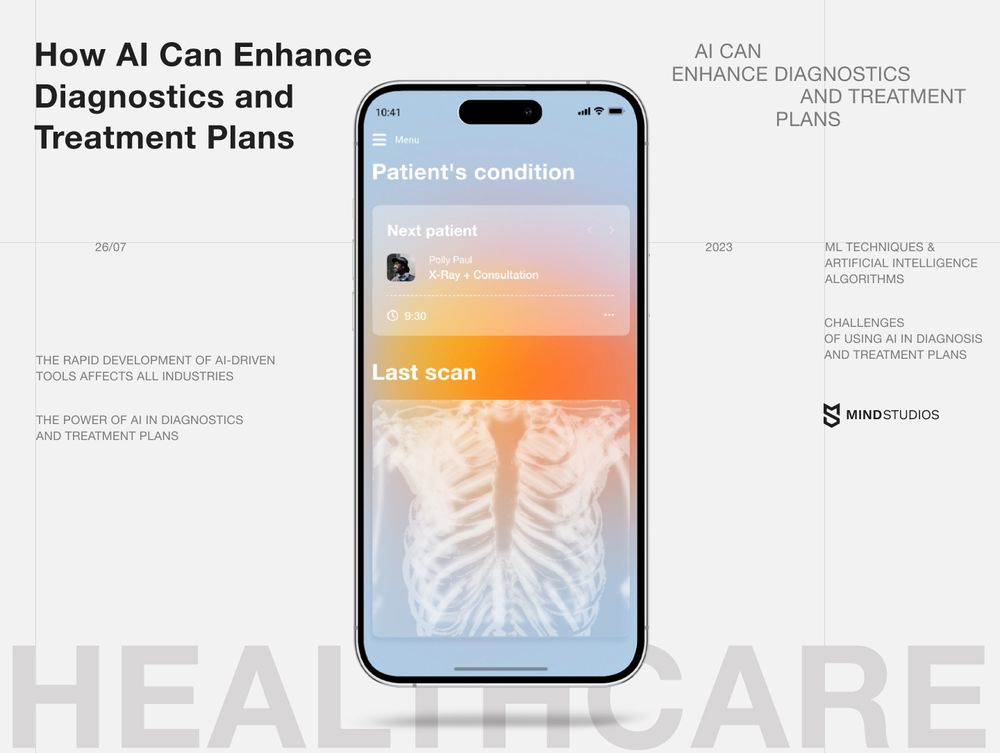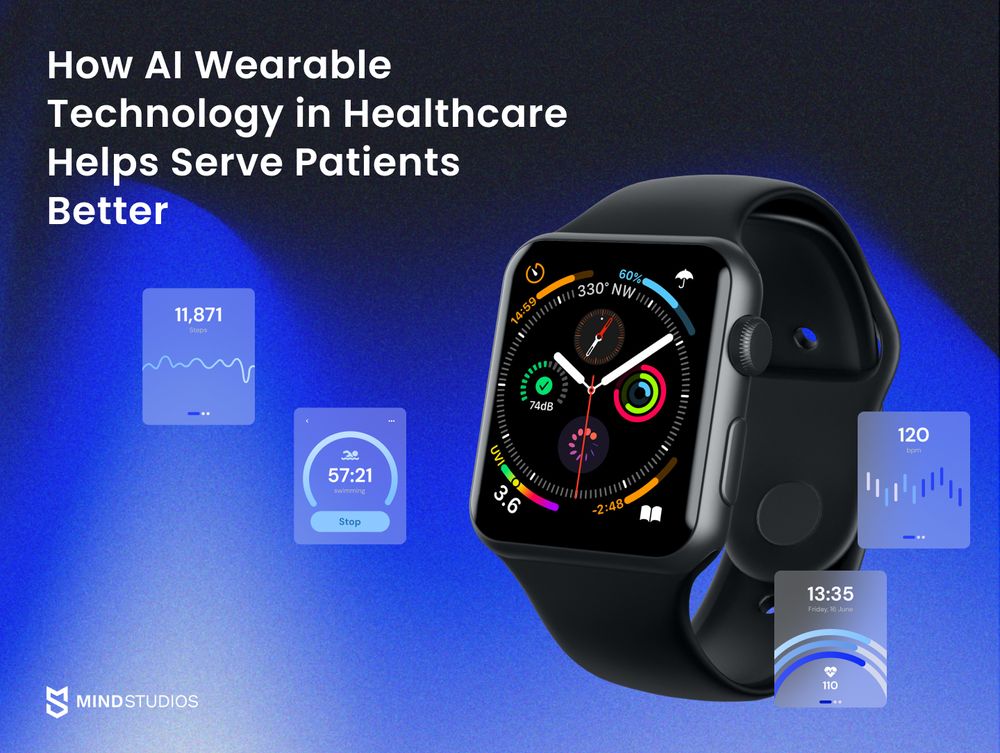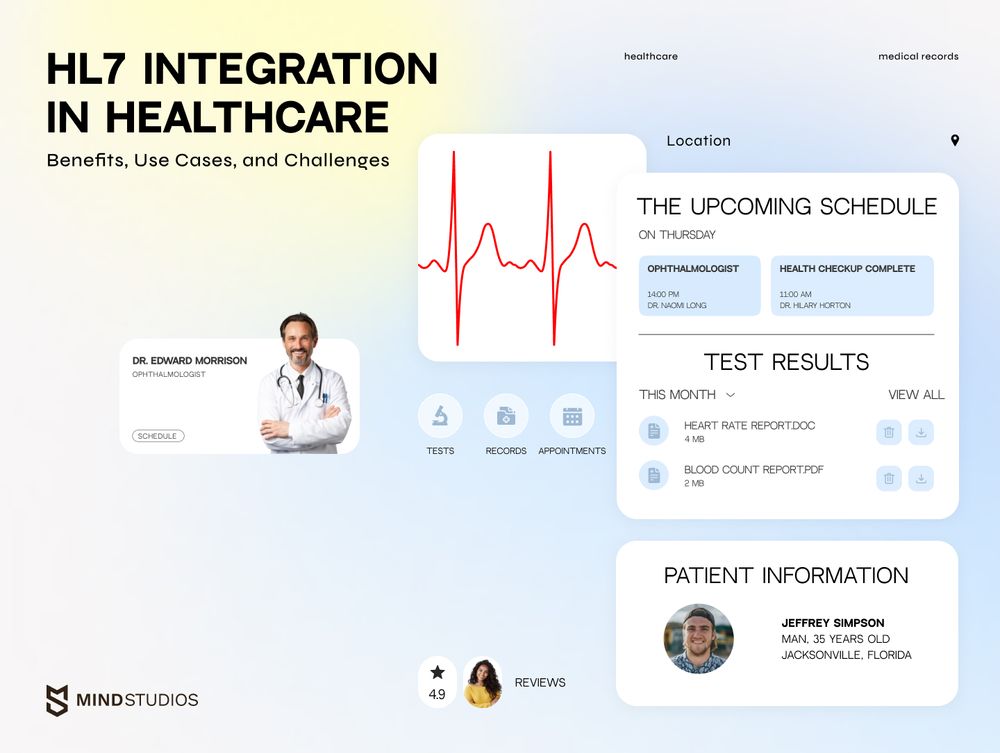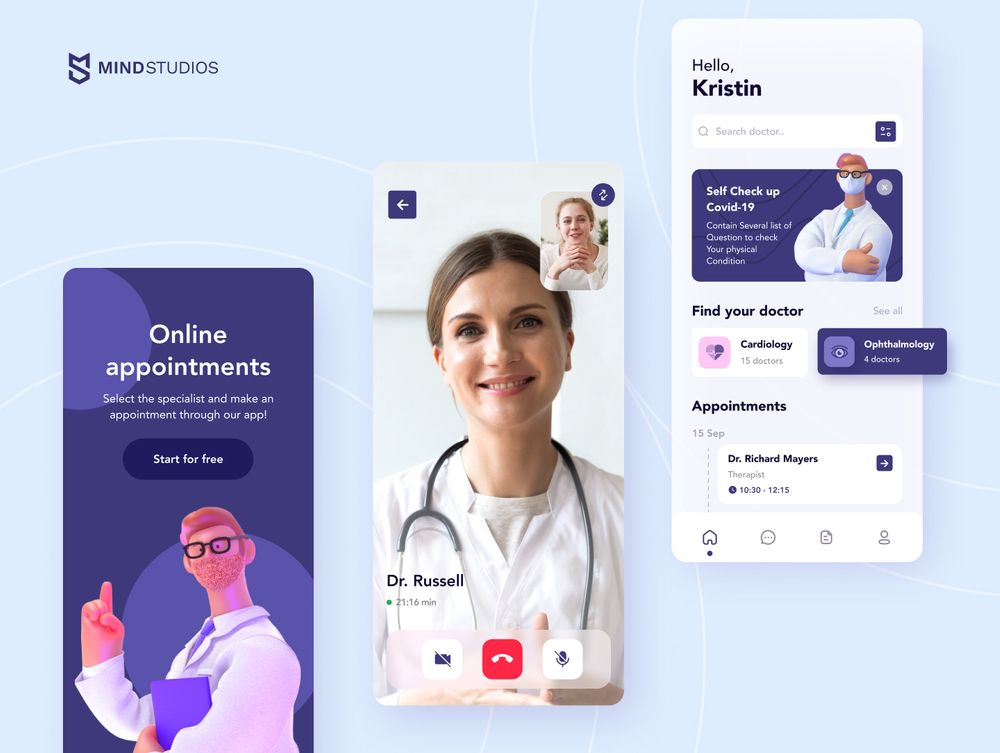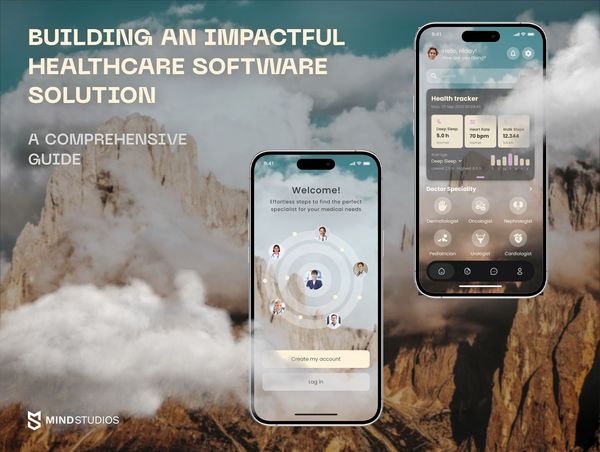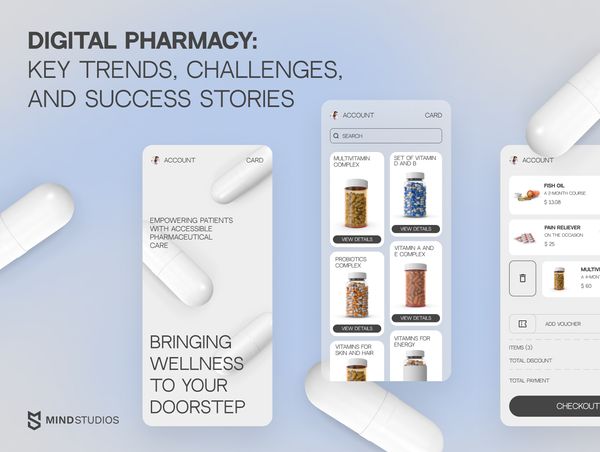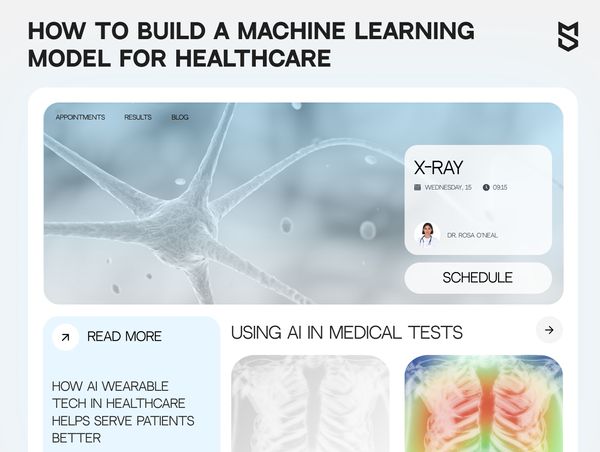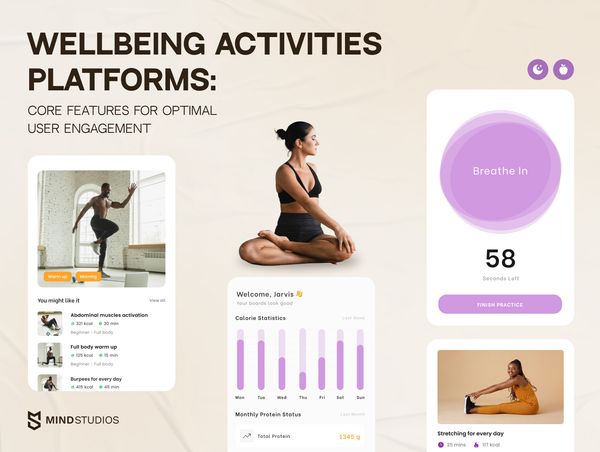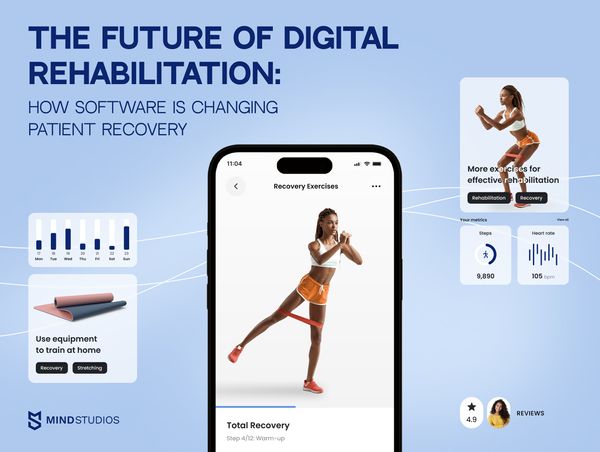
Physical therapy and rehabilitation, in particular, is a type of healthcare that has historically depended on hands-on techniques to enhance patients' movement, mobility, and functioning. A person may need physical therapy after surgery or while recuperating from an accident to help them restore full function in a specific part of their body. Today, digital rehabilitation may be necessary on top of the traditional physical therapy practices following a medical occurrence.
While customized treatment from a physical therapist remains at the heart of this practice, technological innovations will determine its future. Mind Studios has extensive experience with healthcare apps, including telemedicine. Healthcare and fitness projects have been our focus since our founding. This gives us the expertise to evaluate your project and develop a custom software solution.
This article will examine how innovative health solutions can improve patient outcomes, assess their implementation challenges, and offer solutions. Continue reading to discover how rehabilitation specialists can benefit from digitalization and new tracking technology and ultimately help patients. And contact our experts if you need help with your idea.
Benefits of utilizing digital software in rehabilitation
The digital health market is predicted to experience a compound annual growth rate (CAGR) of 9.23% from 2024 to 2028, leading to a projected market volume of $274.32 billion by 2028. This growth shows how digitalization affects all parts of healthcare, so healthcare providers should learn more.
Digital networking helps improve care for individuals in rural regions, for those dealing with chronic illnesses, and for the elderly. This approach is essential, given the ongoing structural and demographic changes. All parties, including healthcare providers, technology developers, and policymakers, should work together to integrate eHealth and telemedicine solutions for better routine treatment. Let's explore why it's important by taking a look at the core benefits of incorporating digital health solutions into the patient rehabilitation process.
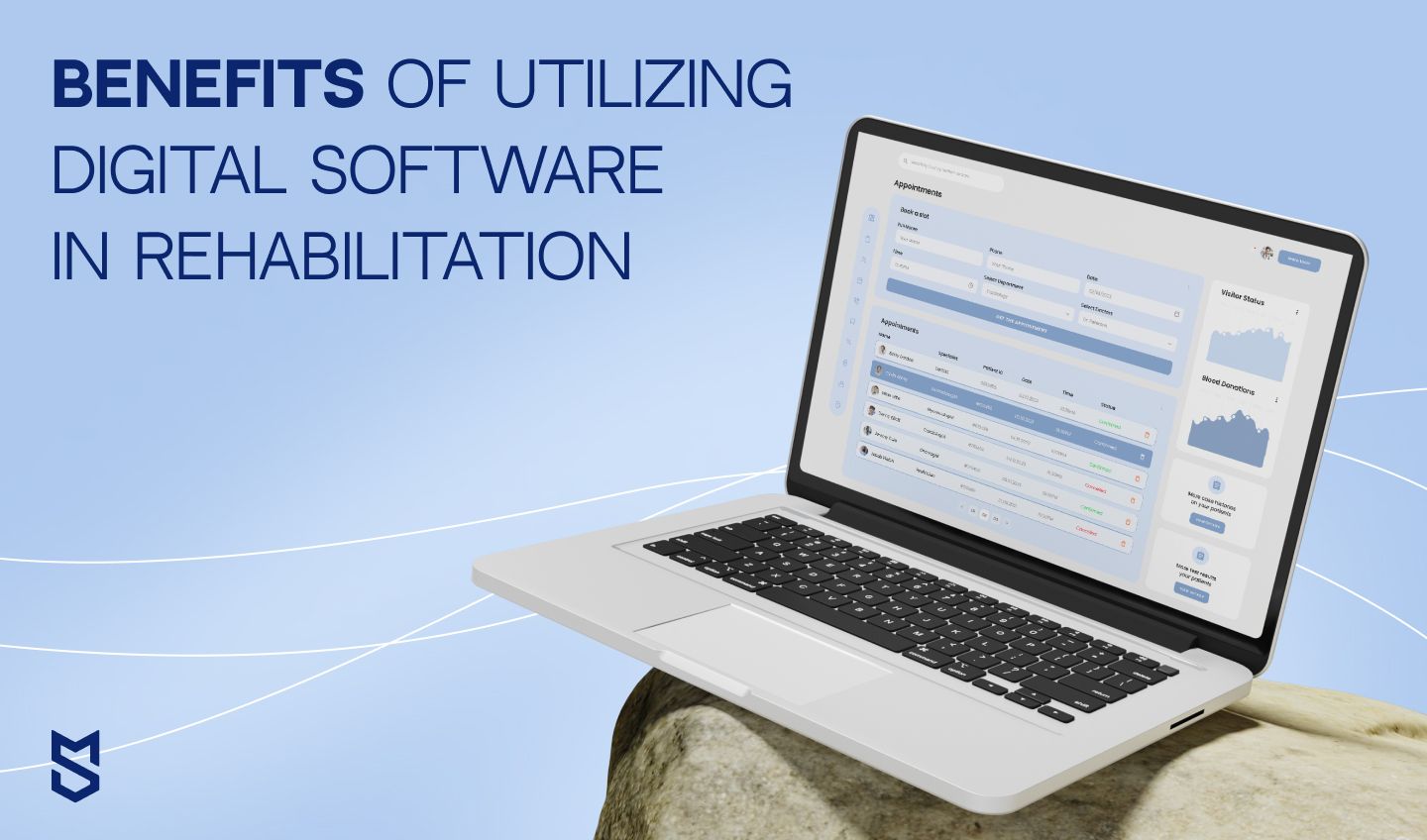
Remote patient monitoring
Modern technology facilitates remote patient monitoring (RPM), allowing doctors to track patients beyond the hospital setting. Benefits include improved patient engagement, enhanced communication with healthcare practitioners, and increased access to virtual healthcare. In physical, occupational, and speech therapies, remote therapeutic monitoring (RTM) employs real-time monitoring via digital platforms or wearable devices. Physical therapists monitor motion, exercises, and vital signs, optimizing rehabilitation through tailored instructions and regimen adjustments.
Occupational therapists use RTM for adapting equipment and monitoring fine motor skills, enhancing patients' functional capacities. Likewise, speech-language pathologists track language development, articulation, and swallowing function using specialized apps or telepractice platforms. RTM promotes early issue detection, regular therapy participation, and accessible treatment for diverse patient needs. Typically, remote patient monitoring:
- Improves patient care and outcomes through early detection and intervention;
- Lowers the risk of complications and improves patient outcomes;
- Allows for rapid interventions and therapy modifications;
- Improves healthcare access;
- Eliminates geographical barriers for remote patients;
- Increases access to specialized care and expert opinions;
- Improves healthcare services in underserved communities by reducing the need for frequent in-person visits, particularly for elderly patients or patients with disabilities;
- Improves patient outcomes and efficiency, resulting in long-term cost savings;
- Lowers hospitalizations and emergency room visits;
- Reduces hospital readmissions thanks to the proactive approach;
- Allows for the effective allocation of healthcare resources.
Personalized treatment plans
When patients feel their healthcare practitioners fully understand their specific needs, they are more inclined to participate actively in their treatment. Care management systems enable patients to take control of their health by giving them access to their data, personalized health advice, and self-management tools. This level of participation develops a collaborative partnership between patients and physicians, resulting in improved health outcomes. Below are the main benefits of using personalized treatment plans in rehabilitation:
| Benefit | Reasoning |
|---|---|
| Tailored care | Plans are tailored to individual health conditions and preferences. |
| Improved outcomes | Considering medical history, genetics, and lifestyle increases therapy efficiency. |
| Patient engagement | Personalization encourages active treatment participation, improving adherence. |
| Efficient resource allocation | Focusing on individual requirements reduces unneeded interventions while optimizing resource use. |
| Prevention and early action | Tailored strategies include preventive procedures, allowing early detection of potential health risks. |
Preventing difficulties during rehabilitation using proactive insights
Care management technologies that analyze past patient data can detect early warning indications of impending health issues. For example, if the glucose levels of a patient with diabetes show a pattern of instability, the system can notify healthcare providers to intervene before the situation worsens. This proactive strategy helps avoid unnecessary difficulties and decreases the need for emergency interventions and hospitalizations. Below are the main advantages of using data-driven insights with digital or remote rehabilitation plans:
- Precision in treatment: Data-driven insights enable personalized rehabilitation therapies based on individual progress and needs.
- Objective monitoring: Real-time data enables objective monitoring of patient performance, improving accuracy in judging rehabilitation outcomes.
- Adaptive interventions: Insights enable therapists to adapt and adjust rehabilitation regimens, maximizing effectiveness.
- Enhanced patient engagement: Patients receive individualized data-driven feedback, encouraging active engagement and adherence to rehabilitation regimens.
Key digital technologies
Digital physical therapy has the potential to alleviate pain and improve mental health, according to the research. It also has additional benefits, such as a decrease in surgical procedures, an improvement in sleeping patterns, a reduction in healthcare expenditures, and an increase in productivity.
Digital technologies can help to ensure long-term quality in rehabilitation. Online appointments via digital doctors enable mobile rehab tech and long-distance care. A computer, for example, can take over writing and speaking tasks based on eye movements.
Moreover, wearable gadgets have quickly become among the most visible pieces of technology in any physical therapy practice. Wearable technology enables physical therapists to carry out care plans remotely and collect patient data in real time. Here are the technologies that exemplify the benefits of digital rehabilitation.
Telemedicine
Telemedicine or telehealth is the practice of offering virtual healthcare, which is especially beneficial for patients who are unable to go to a physical clinic due to limited mobility or other reasons. The impact of digital technology in healthcare is evident, and telerehabilitation improves accessibility, increases patient success rates, and ensures that patients adhere to their physical therapy treatment plan for longer.
For example, when dealing with the long-term effects of COVID-19, telerehabilitation can be a lifesaver. Results show that it helps post-COVID-19 syndrome patients with their physical performance, exhaustion, depression, and overall quality of life. Studies have shown that compared to typical rehabilitation programs, telerehabilitation provides more engagement, customization, and accessibility.
Telehealth and digital health consulting
For several reasons, including but not limited to lower healthcare costs, better accessibility to specialists, better continuity of care, and more effective follow-up care for chronic illnesses, remote healthcare has emerged as an essential answer. By facilitating real-time contact between patients and healthcare providers, telemedicine offers innovative solutions through virtual consultations and remote monitoring. Online consultation tools, including appointment booking and video conferencing, enable doctors to evaluate patients in real time.
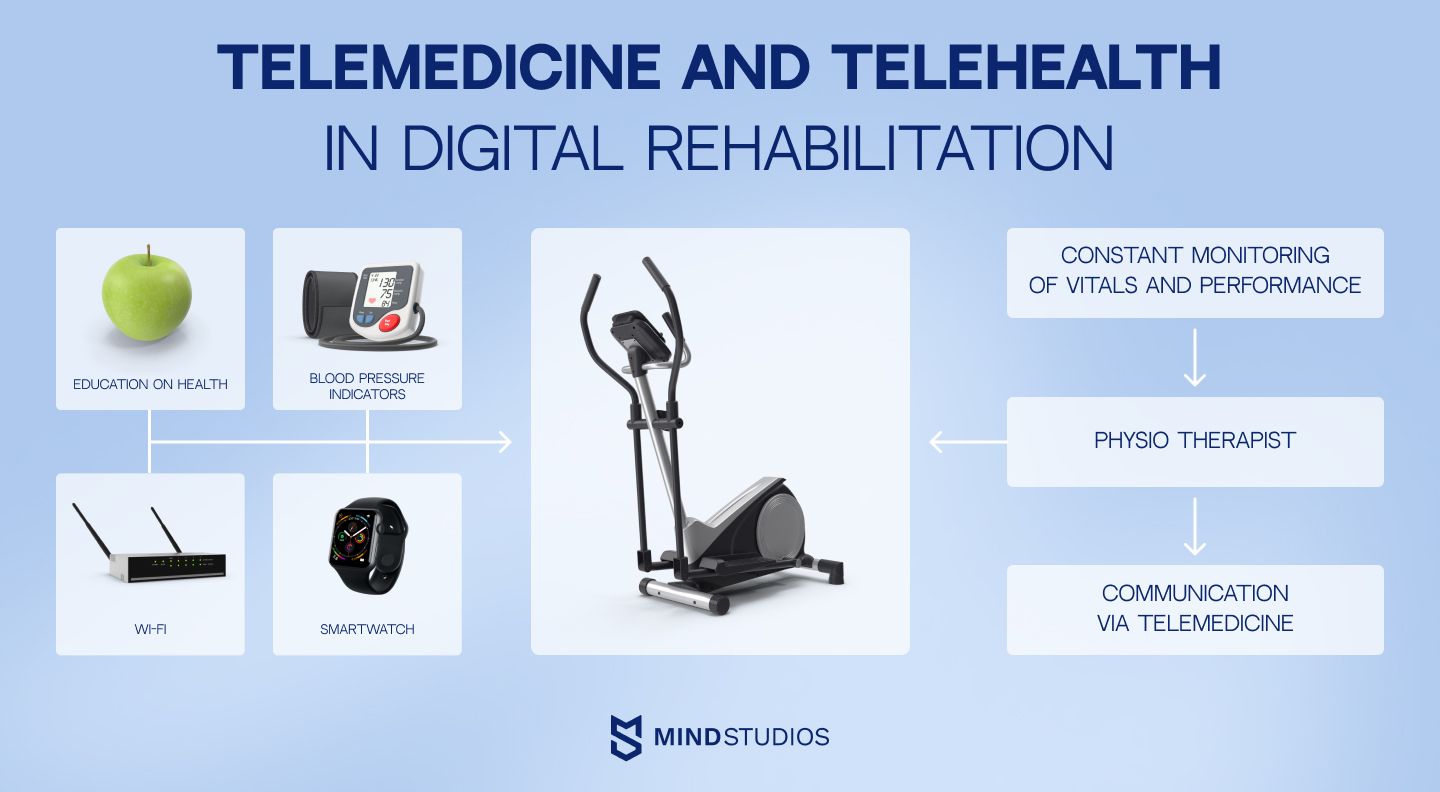
RPM and EHR systems for rehabilitation
Doctors can use RPM systems to keep tabs on their patients' vitals from afar, improving response times and allowing for more personalized care. By consolidating patients' medical records into one place, electronic health records (EHR) systems make it easier to manage data and make educated decisions.
With mobile health applications like mHealth, patients now have access to a wealth of healthcare services, including symptom monitors, medication reminders, appointment scheduling, health education materials, and the ability to have teleconsultations. These apps promote improved communication with healthcare practitioners, increase treatment adherence, and encourage active engagement in healthcare management.
Lastly, remote healthcare creatively answers problems, including limited specialist availability, fragmented treatment, and geographical obstacles. Nowadays, physicians can provide top-notch treatment regardless of location because of the use of digital technology in healthcare, such as virtual consultation platforms, remote patient monitoring systems, electronic health records systems, and mobile health applications.
Virtual reality in rehabilitation
One of the biggest changes in physical therapy is virtual and augmented reality (VR/AR) therapy. The VR market in physiotherapy and healthcare is expected to grow at a CAGR of over 27% between 2024 and 2029 as physical therapists discover its benefits for patient treatment and motivation.
A virtual reality physical therapy patient may wear a headset and work in peaceful, natural settings. Perhaps they're in a gaming world where they must perform precise physical therapy actions. Physical therapists are discovering that patients are more likely to stick with their treatment plans when they incorporate virtual reality and gamified digital health innovations.
Virtual reality is becoming more prevalent in stroke therapy and other rehabilitation fields. It helps patients exercise better than during traditional physical therapy, since it provides a more fun experience for the patients. The technology's benefits include adaptability, patient education and motivation, history-based variability, data transparency, lower healthcare costs, and resource efficiency.
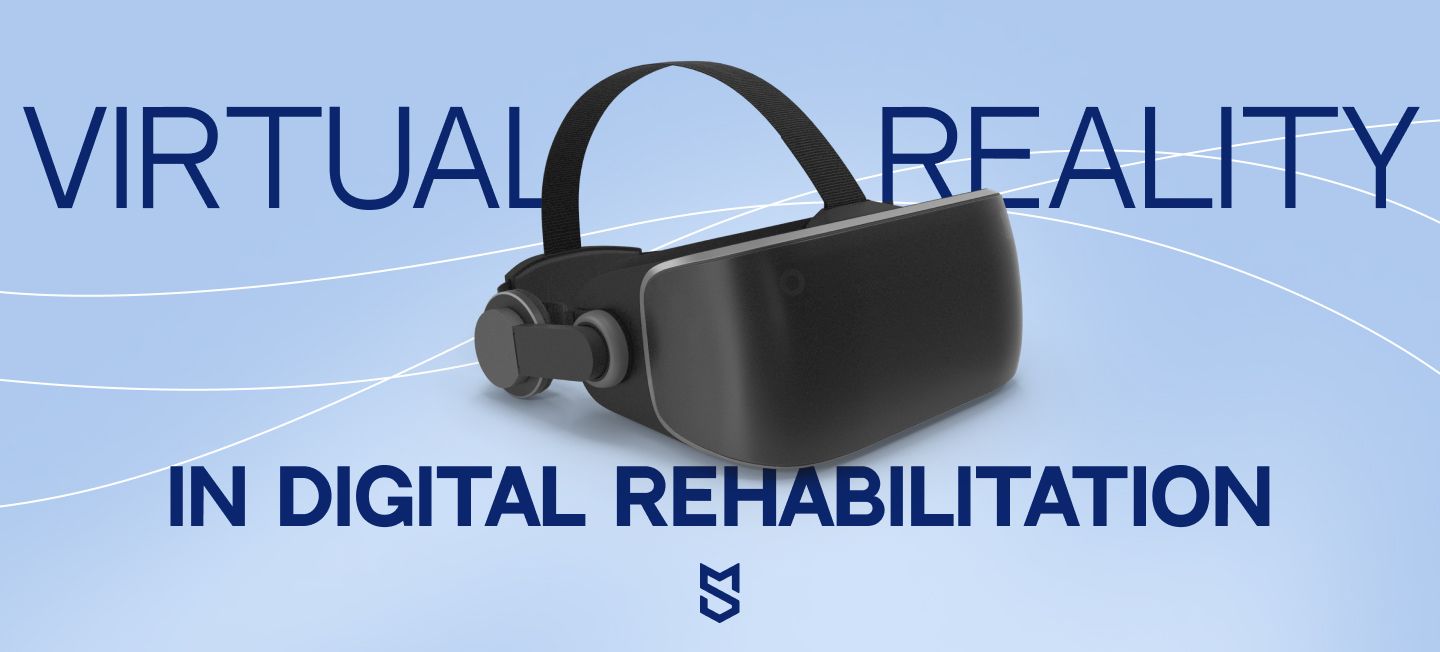
Virtual reality can help stroke survivors self-care by simulating everyday tasks. Because of its adaptability, user feedback, stimulus control, and autonomous practice are easy to record. Virtual reality helps patients cope with unpleasant sensations, speeding up pain recovery.
In cancer rehabilitation, virtual reality can reduce pain, improve memory and vision, and improve health. To reduce tumor size and improve disease-free outcomes, chemotherapy VR is recommended. Symptoms like nausea, vomiting, exhaustion, sleep problems, and depression can lower the quality of life of chemotherapy patients. VR rehabilitation and other immersive distraction interventions eliminate unpleasant symptoms in therapeutic settings by focusing on positive stimuli.
Finally, virtual reality has shown great promise as an alternative to conventional physical therapy in rehabilitation, providing several advantages like enhanced patient engagement, customizable environments, safe practices, real-time feedback, cognitive rehabilitation, among others.
Wearable technology
Patients can track their vitals and fitness levels with wearable gear, they can share this data with their healthcare providers and insurers. Fitness trackers, blood pressure monitors, and biosensors are just a few examples.
Wearable medical gadgets, such as fitness trackers, smartwatches, ECG monitors, blood pressure monitors, and biosensors, have seen a surge in demand due to advantages like improved compliance, remote monitoring, objective data collection, real-time physician intervention, increased patient independence. What about physiotherapy and wearable technology, though? Well, here is an overview of the current use of these tools in the field of physical therapy and rehabilitation:
Skin sleeves
These devices are easy to wear for all ages and abilities. Skin sleeves track biometric data and send it to the patient’s physical therapist to ensure that the patient is following treatment plans. A skin sleeve technology helps with pain management and mobility by increasing circulation, decreasing swelling, and providing a feeling of stability. Warmth and light pressure can help ease the pain and speed up recovery. Also, skin sleeves can help with motor learning and rehabilitation by acting as a visual cue for moving and aligning joints correctly.
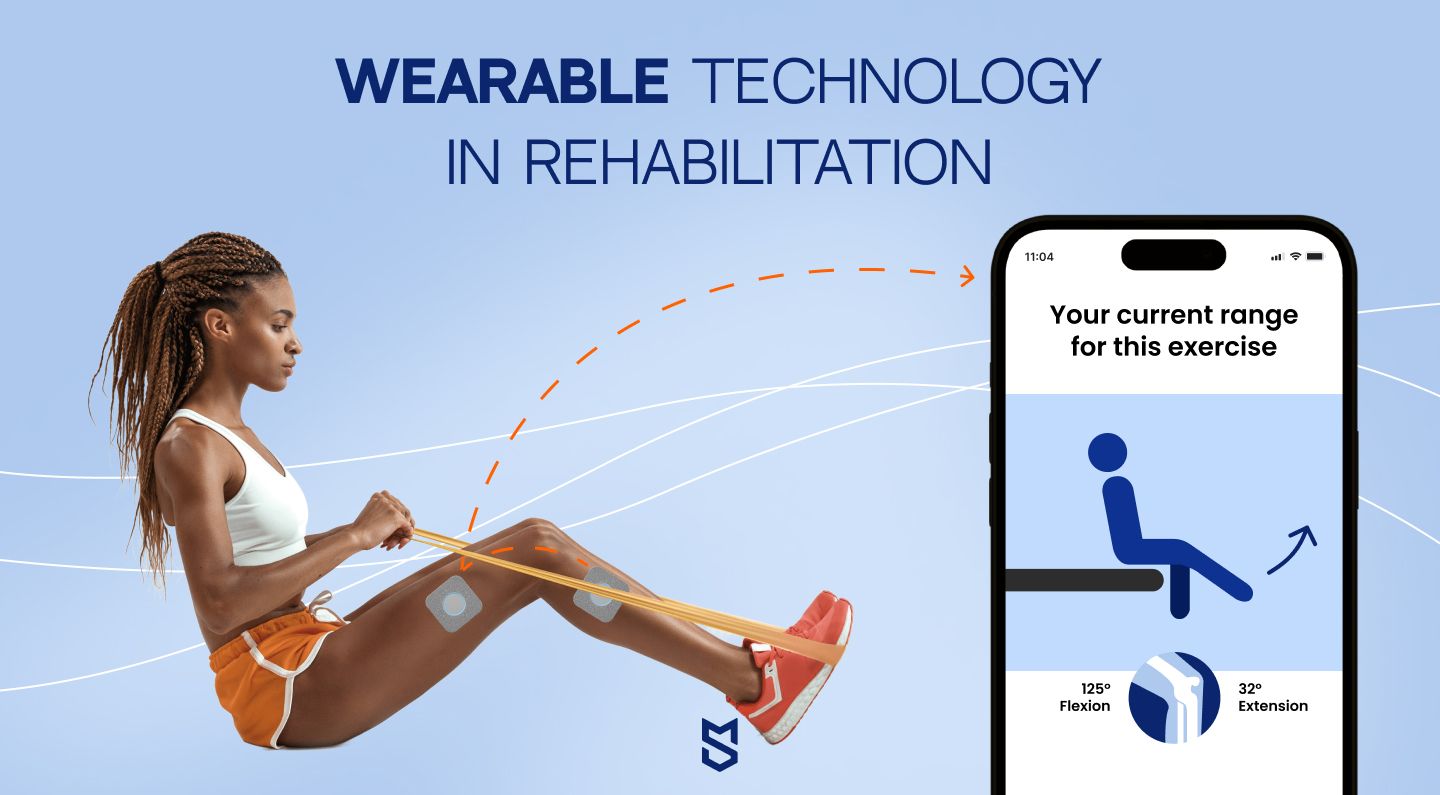
Smartwatches & fitness trackers
Nowadays, smartwatches and fitness trackers are popular physical therapy equipment. Whether in physical therapy or not, people use these wearable devices to track their heart rate, meals, and steps. In physical therapy, fitness trackers and smartwatches help track patient progress and adjust treatment plans. Fitness trackers and smartwatch sensors can be connected to the physical therapists' equipment and programs to monitor a range of motion and make adjustments.
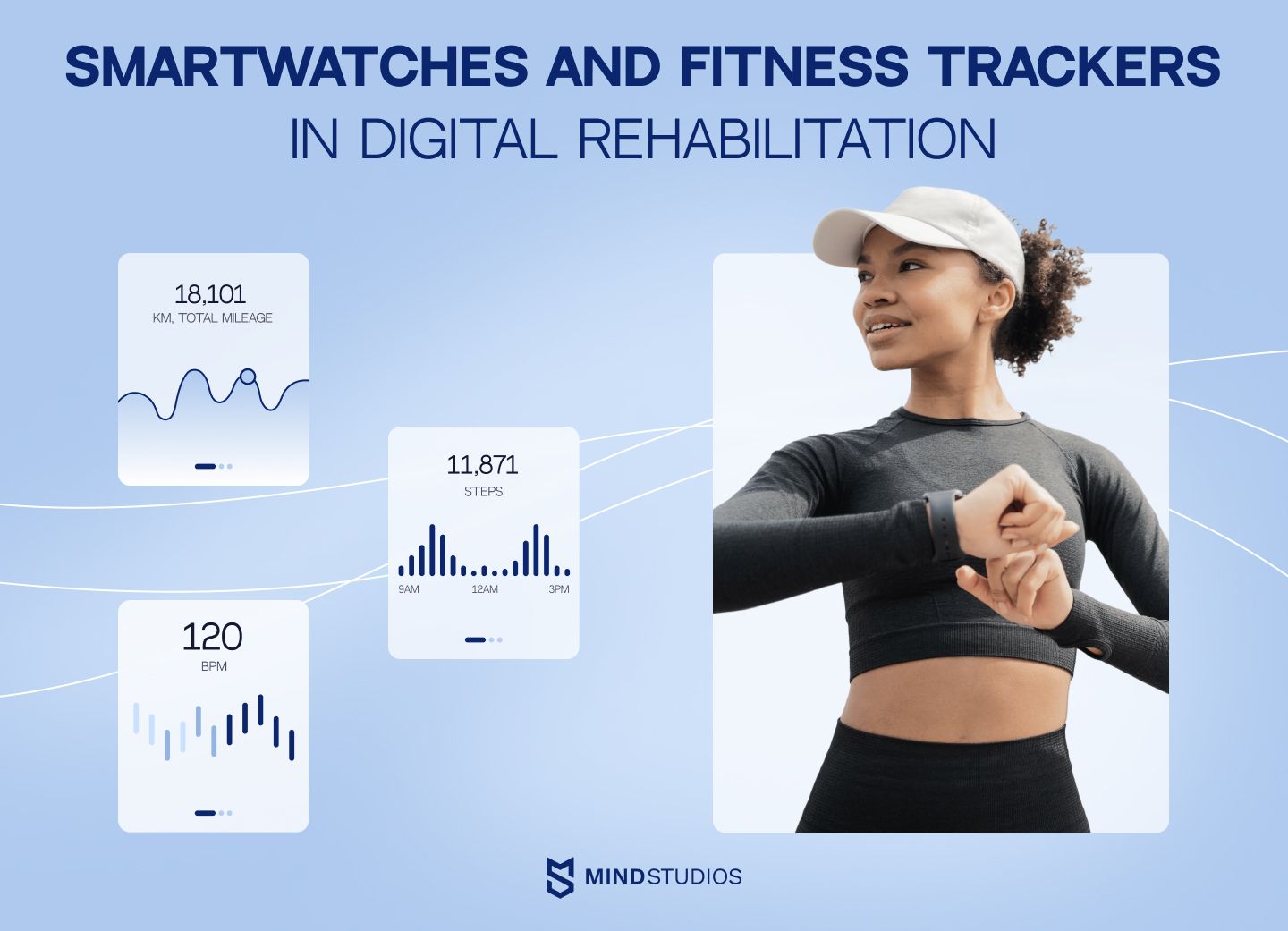
Sensor technology
Sensors may be the biggest physical therapy technology advancement today. These discreet devices can be placed in several high-impact areas to help physical therapists collect biometric data and improve health and therapy outcomes.
One innovative way physical therapists use this technology is to insert a sensor into a patient's sock to assess foot contact or to embed a sensor in clothes to collect data, which can improve the rehabilitation process.
Fall detection devices
Accidents involving slips and falls are especially dangerous for seniors. Fall detection systems improve reaction time and prevent major damage by alerting authorized personnel when a patient falls. New healthcare technology can evaluate medical data and warn patients of impending health issues that could cause falls.
Challenges in implementing digital solutions in rehabilitation
Digital transformation is an important part of upgrading healthcare systems, as it aims to replace outdated solutions and processes with current ones. Healthcare facilities are no exception, as they are at the forefront of efforts to improve patient care quality and efficiency. Artificial intelligence algorithms are already being used to detect sickness signals that humans cannot see, and machine learning and computational science enable scientists to tailor therapies and drugs based on genetic profiles. However, transitioning to more advanced technologies and solutions can be challenging for hospitals, medical organizations, and patients.
Shortage of IT specialists
One of the obstacles to digital transformation in the healthcare industry is a lack of IT expertise. The current healthcare scenario necessitates the quick introduction of informational technologies. However, there are insufficient IT specialists to meet expanding demand. The chronic cybersecurity and IT workforce scarcity is a major barrier to hospitals implementing innovative healthcare technologies.
The lack of talent in healthcare IT is considerably worse. It goes without saying that entrusting health technology to someone who has never dealt with it may result in unforeseen consequences such as data breaches, difficulties managing large amounts of data, and poor process optimization, among others.
While the staff shortage makes it difficult to digitalize healthcare globally using only local in-house expertise, it is doable if healthcare organizations collaborate with healthcare-experienced outsourcing businesses. By partnering with outsourcing companies, healthcare organizations can tap into a vast pool of tech talent worldwide, expanding their reach beyond local specialists. Looking for a tech partner? Mind Studios has the needed skills, thanks to our long history of working on healthcare projects and startups.
Data protection and safety regulations
Healthcare providers also have challenges complying with data privacy standards such as HIPAA and GDPR. Data security is especially important when data is shared across multiple systems and solutions. Hospitals can work with companies specializing in developing HIPAA-compliant software solutions to tackle this challenge.
Outdated legacy systems
Old and outdated legacy systems pose major security and integration risks, and healthcare relies on a wide range of outdated medical devices and systems that cannot be patched or upgraded. According to Cisco, 60% of these devices have reached the end of their life cycle, posing substantial security and integration issues. Before releasing new updates and full applications into the field, detailed upgrade planning is required, including testing systems for compatibility.
Integrating new solutions and devices into existing healthcare systems
Incorporating new technologies and gadgets, such as IoT devices and biosensors, into existing health systems can help reduce inefficiencies and save the healthcare industry more than 10% of nationwide expenditures annually, according to a 2023 Cisco report.
However, the compatibility between older systems and new tech might become an issue. Working with service providers and developers experienced in health tech in particular can help reduce risks and ensure the integration process goes well.
Case studies
There are many examples of successful implementations of digital platforms for rehabilitation in healthcare, down below are just a few examples of how software and wearable devices can aid the rehabilitation process.
Home-based education and exercise platform for total knee arthroplasty patients
The effectiveness of a digital rehabilitation program for patients undergoing total knee arthroplasty (a surgical procedure to resurface a knee damaged by arthritis) was investigated in a study published in the Journal of Personalized Medicine in 2023. The program was based on a personalized and adaptive app.
During the tests, a physical therapist oversaw the innovative rehab program's home-based education and exercise through encrypted chat messages. Exercise delivery, adherence assessment, and educational article distribution were all facilitated by daily patient feedback. A smart alert system was implemented to notify doctors during unexpected events.
During the studies, fourteen participants withdrew from the trial, while the average adherence to digital programs during rehabilitation was 77%. Two patients accounted for 2.4% of the hospital readmissions.
Significant improvements in patient-reported outcomes, low complication rates, and high patient engagement were all observed in the study. Patients were very pleased with the results of the digital rehabilitation program. This research suggests that digital rehabilitation can enhance patient outcomes, decrease healthcare costs, and direct communication between patients and doctors.
For patients undergoing total knee arthroplasty, digital rehabilitation offers a viable and efficient substitute for traditional in-person rehabilitation. Arthroplasty pre- and post-operative care pathways can benefit from digital solutions because they increase patient adherence, satisfaction, and postoperative outcomes.
Anterior cruciate ligament rehabilitation with a wearable digital device
Another study from a collaborative group of researchers, medical specialists, and hospitals was published in 2023 by the Journal of Personalized Medicine. This study investigated the effectiveness of a digital medical device (DMD) in objectively measuring knee joint function during rehabilitation following anterior cruciate ligament (one of the key ligaments that help stabilize the knee joint) injury. Following ACL surgery, young and athletic patients utilized the DMD in conjunction with normal therapy and a home-based rehabilitation regimen.
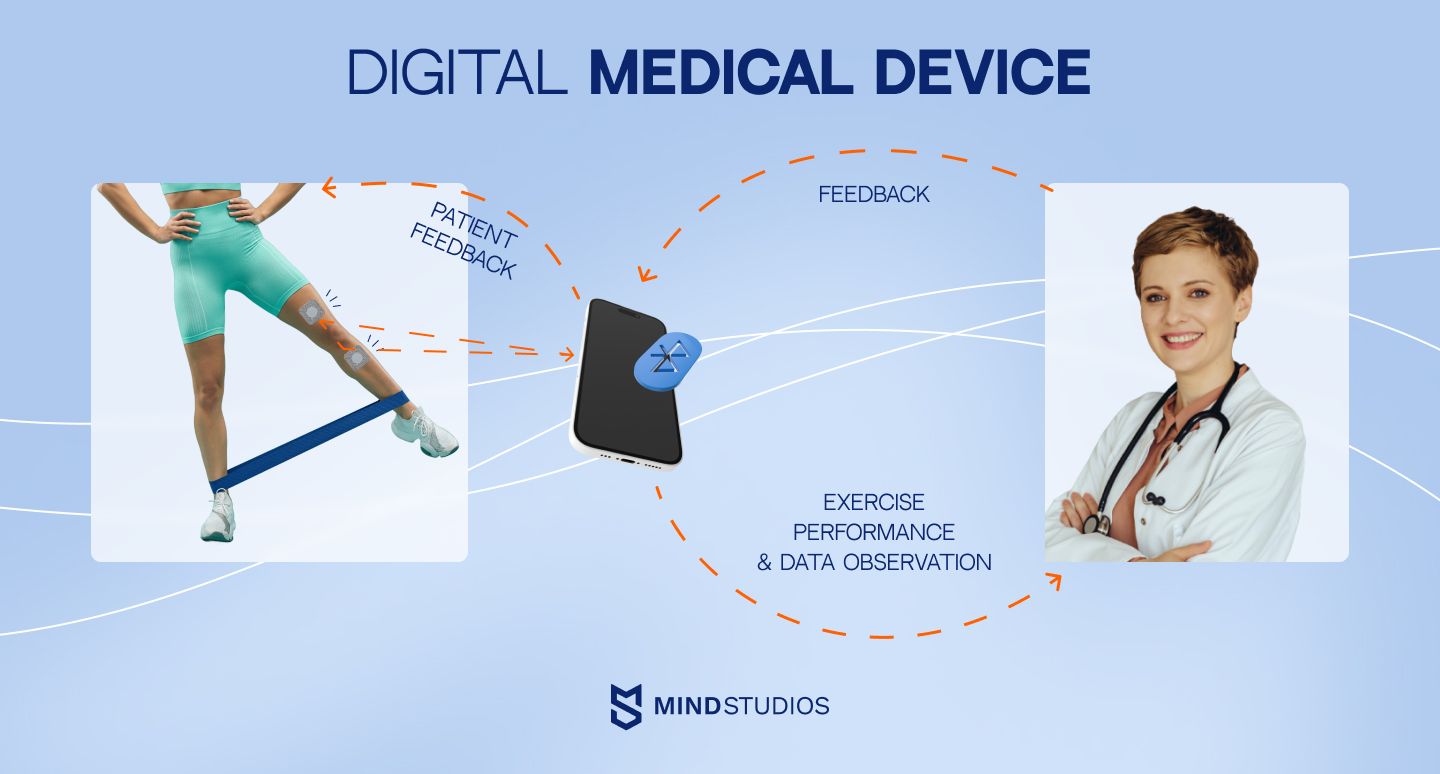
This study found substantial correlations between DMD outcomes and patient-reported measures such as the International Knee Documentation Committee Subjective Knee Form (IKDC-SKF) and the Lysholm Score. The DMD, a small sensor attached to a strap, gave objective data, with a one-leg vertical leap and side hop being excellent indications of functional knee recovery. The study implies that incorporating such DMDs into clinical practice and research can improve the success of rehabilitation programs.
Final thoughts
Digital transformation is crucial in changing patient care as we adapt to the ever-changing healthcare landscape. Technologies such as telehealth, virtual reality, and wearables that measure real-time movements are reshaping rehabilitation methods by removing geographical limitations and providing immersive therapeutic experiences. Telemedicine guarantees accessibility and adherence to treatment programs, while smartwatches, skin sleeves, and fall detection technologies are increasingly important in physical therapy.
Integrating electronic health record systems with Big Data can optimize rehabilitation processes and improve patient outcomes. In the future, technology will play a crucial role in providing effective and patient-centric rehabilitation. This is demonstrated by the benefits of tailored treatment programs and the rise of telehealth.
At Mind Studios, we have worked with healthcare platforms for nearly as long as the company has existed. We've executed a wide range of healthcare projects, from veterinary knowledge base systems to HIPAA-compliant applications that connect patients with doctors.
We also have experience developing secure, high-quality video call capability required for any telemedicine platform. We have all the expertise required to develop high-quality telemedicine and rehabilitation apps.
If you have an idea, we can shape it into a solid concept together. If you require an evaluation of your project and to plan the future stages, feel free to contact our experts today.

